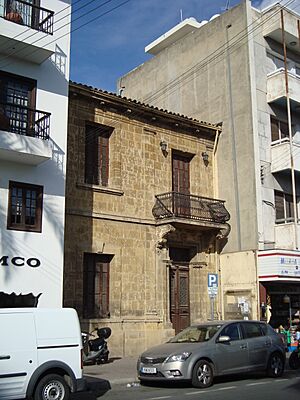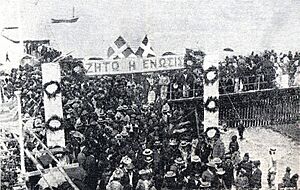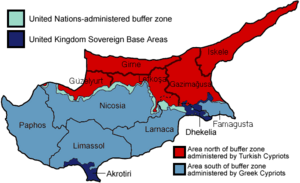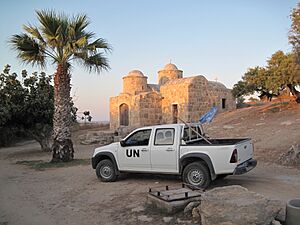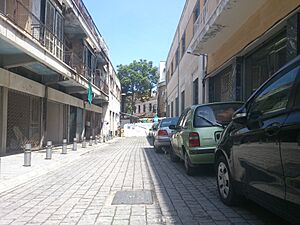History of Cyprus (1878–present) facts for kids
Cyprus was once part of the British Empire. It became an independent country in 1960.
Contents
Cyprus Under British Rule (1878-1960)
How Britain Took Over Cyprus (1878-1914)
In 1878, the United Kingdom took control of the island of Cyprus from the Ottoman Empire. This happened because of an agreement called the Cyprus Convention. Britain promised to help the Ottoman Empire if Russia tried to take its lands.
The first British leader in Cyprus was called the "High Commissioner". His name was Lieutenant-General Sir Garnet Joseph Wolseley. When the British arrived, many Cypriots, especially the Greek Cypriots, hoped that Cyprus would eventually join Greece. This idea was called enosis.
In 1881, the British counted the people on the island. Out of 186,173 people, about 74% were Greek Cypriots and 24% were Turkish Cypriots. The rest were smaller groups like Maronites and Armenians.
At first, Cypriots welcomed the British. They hoped for a better life, more freedom, and eventually, to join Greece. However, they soon felt disappointed. The British made them pay high taxes to cover the money Britain paid to the Ottoman Sultan for Cyprus. Also, Cypriots were not allowed to help run the island. All the power stayed with the High Commissioner and the government in London.
Cyprus as a British Colony (1914-1960)
Cyprus stopped being a protectorate in 1914. This was when the Ottoman Empire went to war against Britain and its allies in World War I. Britain then officially took over Cyprus on November 5, 1914.
In 1925, Britain declared Cyprus a Crown colony. This meant it was directly ruled by the British Crown. The new constitution was not very democratic.
After World War I, in 1923, a new agreement called the Treaty of Lausanne officially recognized Britain's control over Cyprus. In the late 1920s, some Cypriots were allowed to be elected to a council, but they had very little power. This council was removed in 1931.
Greek Cypriots strongly wanted to unite with Greece. This desire for enosis grew in the 1930s. In 1931, protests became violent, and the Government House in Nicosia was burned down during the 1931 Cyprus Revolt.
The "Palmerokratia" Period (1931-1940)
The years between 1931 and 1940 were tough for Cypriots. The Governor, Sir Richmond Palmer, put in place strict rules. He limited Greek schools and banned groups like trade unions. This period was called "Palmerokratia," named after him. Its goal was to stop people from getting involved in politics.
These strict rules were not lifted until Second World War began. During the war, more than thirty thousand Cypriots joined the British armed forces.
The Push for Union with Greece
After World War II, the idea of enosis became even stronger. In 1948, King Paul of Greece said that Cyprus wanted to join Greece. In 1950, the Orthodox Church of Cyprus held a vote. About 97% of Greek Cypriots voted to unite with Greece.
Britain rejected this demand but offered a new constitution and a plan for social and economic improvements.
In the 1950s, Archbishop Makarios III led the Greek Cypriot demand for enosis with new energy. Greece also started supporting this idea on the world stage. This worried Turkey and the Turkish Cypriots.
Britain also moved its Middle East military headquarters to Cyprus after leaving Egypt.
The Cyprus Emergency (1955-1959)
When international pressure didn't work, violence started. A group called EOKA (National Organisation of Cypriot Fighters) began a campaign against British rule in 1955. Their leader was Colonel George Grivas.
EOKA started with bombs and leaflet drops on April 1, 1955. Attacks on police stations followed in June. The British Governor declared a State of Emergency on November 26, 1955.
For the next four years, EOKA attacked British targets and Cypriots they saw as helping the British. Archbishop Makarios and other leaders were sent away to the Seychelles. Many British soldiers died fighting EOKA.
The British security forces worked hard to stop EOKA. They were quite successful, but attacks on British personnel continued. Makarios was eventually released when EOKA agreed to stop fighting if he could return.
Turkish Cypriots and Partition
The Turkish Cypriot community had a different idea for the future. They wanted the island to be divided, a plan called taksim. This was their answer to the Greek Cypriot call for enosis. In 1957, a Turkish Cypriot leader named Küçük said that Turkey would claim the northern part of the island.
By 1957, Britain became more open to solving the problem with Greece and Turkey. Violence continued, and fighting between Greek and Turkish Cypriots became a serious issue.
In 1957, the United Nations decided the issue should be resolved. Leaders returned from exile, and both sides continued violent acts against each other.
Before the Zürich and London Agreement in 1959-1960, Greece tried again to get international support for enosis. But it didn't work. Greece had to accept that Turkey was now a very important part of the discussion.
In 1958, British Prime Minister Harold Macmillan suggested a plan for Cyprus that involved a form of partition. Archbishop Makarios rejected it. He said he would only accept a plan that guaranteed independence, without enosis or partition.
The Cypriot Constitution (1959)
On February 19, 1959, the Zürich agreement tried to end the conflict. The United Kingdom created a Cypriot constitution, which was accepted by both Greek and Turkish Cypriots. Greece, Turkey, and Britain became the "guarantors" of the island's safety.
Here are some key points of the agreement:
- Cyprus would become an independent country.
- Both taksim (partition) and enosis (union with Greece) were forbidden.
- Greek and Turkish soldiers would be present in Cyprus.
- The President would be a Greek Cypriot, and the Vice President a Turkish Cypriot.
- The government would have seven Greek Cypriot ministers and three Turkish Cypriot ministers.
- Both the President and Vice President could stop decisions they disagreed with (they had a veto right).
- The United Kingdom would remain a guarantor and keep its two military bases on the island.
Cyprus Becomes Independent (1960)
On August 16, 1960, Cyprus became independent from the United Kingdom. This happened after a long campaign by EOKA. Archbishop Makarios III was elected the first president of independent Cyprus on December 13, 1959. In 1961, Cyprus joined the United Nations.
However, the Zürich agreement did not lead to good cooperation between Greek and Turkish Cypriots. Greek Cypriots felt that the rules protecting Turkish Cypriot interests made it hard to govern effectively. Both sides continued to be violent. Turkey threatened to get involved.
In November 1963, President Makarios suggested changes to the constitution. Turkish Cypriots opposed these changes. This led to widespread fighting in December 1963. Turkish Cypriot members left the government, including the Vice President, Fazıl Küçük.
Makarios called for a ceasefire and asked the United Nations for help. UN peacekeepers were sent to the island in 1964. This force, called UNFICYP, included troops from Canada, Ireland, and Finland. Their job was to prevent fighting and keep order.
In 1964, the Turkish parliament voted to intervene in Cyprus, but they didn't get support from the UN or NATO.
Greek Coup and Turkish Invasion (1974)
In July 1974, the President of Cyprus was overthrown by a 1974 Cypriot coup d'état supported by the military government in Greece.
The Turkish invasion of Cyprus began on July 20, 1974. Turkey said it was acting under the 1960 Guarantee Treaty, which allowed Turkey, Greece, and the UK to intervene if democracy in Cyprus was threatened.
Turkish troops took control of about 38% of the island. Around 200,000 Greek Cypriots fled from the northern areas. At the same time, 60,000 Turkish Cypriots moved to these northern areas. Since then, the southern part of the island has been controlled by the internationally recognized government of Cyprus. The northern part is controlled by the government of Northern Cyprus.
Cyprus Today
In 1983, the Turkish Cypriot-controlled area declared itself the Turkish Republic of Northern Cyprus. Only Turkey recognizes it as a separate country.
UN Peacekeeping Forces maintain a "buffer zone" between the two sides. There was no major fighting from 1974 until August 1996, when two Greek Cypriot demonstrators were killed near the buffer zone.
UN-led talks to find a solution for Cyprus started again in 1999. The Cypriot government does not recognize the northern administration. This means there are no international flights or free trade with the North.
Cyprus and the European Union (2004-Present)
Cyprus joined the European Union on May 1, 2004. In December 2003, the UN buffer zone was partly opened. Since then, people from both communities can cross the buffer zone at certain checkpoints.
In 2004, a UN plan for reunification, called the Annan Plan for Cyprus, was put to a vote. Turkish Cypriots voted to accept it, but Greek Cypriots largely rejected it.
On January 1, 2008, Cyprus joined the Eurozone and started using the euro as its money.
In 2008, Dimitris Christofias became president and started new talks about reuniting Cyprus as a bizonal federal state. In 2013, Nicos Anastasiades was elected president, and he was re-elected in 2018. In 2023, Nikos Christodoulides became the new president of the Republic of Cyprus.
More to Explore
- History of Cyprus
- Timeline of Cypriot history
- Independence Day (Cyprus)


